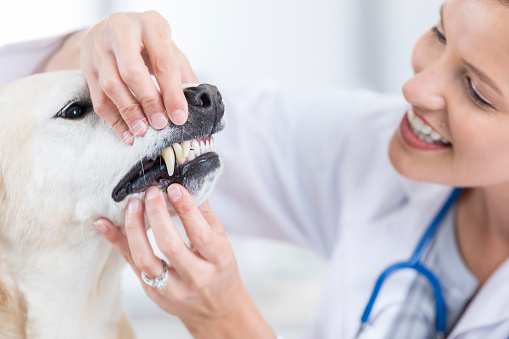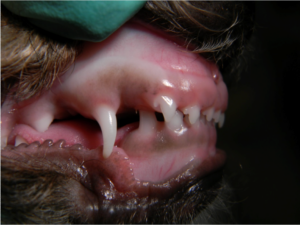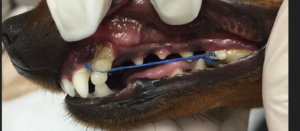
Canine malocclusions, or misaligned teeth, are prevalent in dogs and can significantly affect
their health and quality of life. As a dog’s mouth is the gateway to their overall health,
understanding canine malocclusions and the various methods to correct them is of utmost
importance to ensure their well-being. Our team will help determine if your dog needs braces, an extraction, or another method to correct their misaligned teeth.
Understanding Canine Malocclusions
A malocclusion occurs when there is an incorrect alignment between the teeth of the upper and
lower jaw, causing a problematic bite. It can manifest in several ways, with the most common
types being an overshot bite (Class 2), where the upper jaw protrudes over the lower one; an
undershot bite (Class 3), where the lower jaw is extended, and a Class 4 malocclusion, which is a
skeletal malocclusion with asymmetry in the front to back, side-to-side, or top to bottom
direction. A Class 1 malocclusion is a normal front-to-back relationship of the upper and lower
dental arches with one or more individual teeth malpositioned.
Certain breeds, such as Bulldogs, Boxers, and Pugs, are more susceptible to malocclusions due
to their brachycephalic (shortened) facial structure. While some malocclusions are purely
cosmetic and do not affect the dog’s functionality, others can cause discomfort, difficulty in
eating, and risk of periodontal disease due to overcrowding or misalignment of teeth.
Therefore, a professional evaluation by a board-certified veterinary dentist is crucial to
determine if intervention is necessary. It is commonly believed that dogs don’t necessarily have
to have the perfect “showgirl/boy” bite; however, we are responsible for providing a functional
and pain-free occlusion.
Methods for Correcting Canine Malocclusions
Interceptive Orthodontics: This approach involves the early detection and intervention of a
developing malocclusion, often in puppies. It includes extraction of deciduous (baby) teeth that
may be causing or contributing to a malocclusion, thus allowing the adult teeth to grow in more
correctly.

1. A painful malocclusion in a puppy

2. Painful occlusal trauma
Orthodontic Appliances: These are devices like braces in humans, designed to apply pressure
and gradually move the teeth into proper alignment. Some examples include inclined planes
and orthodontic buttons with elastic chains. These are custom-made for each dog, based on the
severity and type of malocclusion, and require regular adjustments.

3. An active force appliance to correct a malocclusion.

4. An inclined plane to correct a malocclusion.
Tooth Extraction or Reduction: In certain severe cases where other corrective methods are not
suitable, extraction or reduction (shortening) of the teeth might be necessary. This method is
often used in cases where the malocclusion is causing pain or potential harm to the dog.
Jaw Fracture Repair: In very rare cases, surgical alteration of the jawbone may be necessary to
correct extreme malocclusions. This is typically a last resort when all other options have been
exhausted.
It’s important to note that canine orthodontics should never be performed for cosmetic
purposes alone, as the process can be stressful and potentially risky. In addition, it is unethical
to do so in show or breeding dogs. The primary objective should always be to improve the dog’s
health and comfort.
In Conclusion
While malocclusions are common in dogs, they can often be corrected or managed with the
right veterinary intervention. If you notice any abnormalities in your dog’s bite or chewing
habits, it’s important to consult with your board-certified veterinary dentist. Early detection and
intervention can significantly improve the prognosis and quality of life for a dog with a
malocclusion.
As owners and caregivers, our role is to ensure that our pets lead a life of maximum comfort
and health. This means staying informed about conditions such as canine malocclusions and
being proactive in seeking professional advice when needed. After all, a healthy mouth leads to
a happy, healthy dog.
